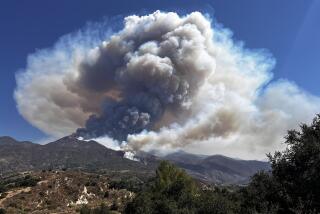A new campfire song: Help!
Ed Forner is 8,000 feet above the vast, sunburned desert. Stomach-dropping mountain ranges unfurl outside the tiny plane’s cockpit, each more spectacular than the last: Panamint, Inyo, Last Chance, Sierra.
But the pilot’s not really looking. Sometimes he can’t see the wild landscape he’s charged with protecting for the roadblocks that Washington keeps throwing in his way, he says. “All I see are stop signs!” he shouts over the engine’s whine.
FOR THE RECORD: Ranger’s name —In Tuesday’s Outdoors section, an article on the National Park Service incorrectly spelled the name of a park ranger as Scott Getterman. The correct spelling is Scott Gediman.
Forner has been a National Park Service ranger for 29 years. He loves his work, considers it a privilege to serve both the public and the land. But he is fed up. And he’s not alone.
Millions of visitors a year hear friendly rangers banter about prehistory at Agate Fossil Beds National Monument in Nebraska or geology at Utah’s Zion National Park. The crisp green and gray uniforms declare that all is right in this nationwide realm of 387 taxpayer-financed battlefields, cemeteries, ruins, seashores, parkways, preserves, scenic rivers, trails and parks. Out of earshot, however, many employees complain about slashed budgets and staffs, and say they fear recrimination if they don’t toe the line.
Forner says that these days he finds himself yanking on and off four hats in his many roles at Death Valley: park pilot, law enforcement ranger, radio dispatch coordinator and wildlife coordinator. The National Park Service family is close-knit, he says. “But the family is pretty demoralized right now.”
As in other families whose budgets are strained, this one has become frightened, worried and tense — some would say dysfunctional.
Working for the park service has always been a calling as much as a job, one with such a shared commitment that staffers often feel like kin. Third-generation rangers and husband-and-wife teams are common. Employees not only go through extensive training together in search and rescue and other skills, they also work together in remote, sometimes searingly beautiful locations, and often live in close quarters in modest housing, paying rent to Uncle Sam.
At Death Valley, all hands pitch in to drive the ambulance or firetrucks or do countless other chores. Before heading to town, 58 miles away, a staffer asks around for video or grocery requests. When a relative is sick or dies, employees donate vacation days to their bereaved colleague.
Beneath the camaraderie lies a devotion to “the mission,” enshrined in the congressional Organic Act of 1916 that created the park service. Any ranger anywhere will rattle it off like the Ten Commandments: “Which purpose is to conserve the scenery, and the natural and historic objects, and the wildlife therein, and to provide for the enjoyment of the same in such manner as will leave them unimpaired for the enjoyment of future generations.”
Many park service employees chose their life’s work because of a childhood memory. For J.T. Reynolds, 57, superintendent at Death Valley National Park, it was a Life magazine photo. His family didn’t visit national parks much — there were few places vacationing black families could spend a night on the road in the segregated South of the 1950s. But that photo of a proud African American park ranger stuck in his head all the way to his junior year of college, when Reynolds decided to join the service.
“It’s a noble cause, preserving Mother Earth,” he says.
Yet many complain that their mission is being undercut. “Any park superintendent who says the national parks aren’t getting slighted isn’t worth their salt,” says Reynolds, a 35-year parks veteran.
He points to evidence: Crumbling ceiling tile is falling on visitors’ heads. The huge Ansel Adams prints that graced the visitor center walls have been pulled down because of ugly stains from spring rains. A volunteer senior citizen now helps clean campground bathrooms. To battle proposed development on the park’s doorstep that could suck dry its fragile water supply, Reynolds is borrowing biologists from other agencies. Death Valley is down 42 positions over the last several years, with 106 left.
Dedicated staff
Reynolds and his wife liked Death Valley immediately for its wide open spaces, and because of the fierce dedication of the staff. “That’s the key holding the parks together. These people will not quit in spite of all the fastballs being thrown at them,” he says.His staff returns the compliment, but worries about him too. “He’s admired here because he’s willing to stick up for Death Valley. We have faith in him. But we don’t want his head to be put on a chopping block,” said Charlie Callagan, a 20-year ranger who has spent the last 14 years at Death Valley.
Many staff at other parks decline to speak on the record, citing the firing of U.S. Parks Police Chief Teresa Chambers in December. Three days after a newspaper story quoted Chambers about budget woes, the park service suspended her and banned her from speaking to reporters. Days later she was terminated. The decision is being reviewed.
Last month a memo advised some national parks to quietly trim hours during the upcoming busy summer season, but to avoid using the word “cuts” to minimize public outcry, instead substituting “service level adjustments.”
“George Orwell wrote about that in ‘1984,’ ” notes Death Valley maintenance worker Matt MacIsaac.
Park rangers are still “paid in sunsets,” and there is still the adrenaline rush of backcountry rescues. But years of shrinking budgets, topped by a push to contract out many park service jobs, and the slaying of a young Arizona park ranger seem to have changed the collective mood.
“It’s a pretty bleak outlook,” says Stacy Allen, with the service for 39 years. He often works seven-day weeks as superintendent at Shiloh National Military Park in Tennessee because of staffing shortages. Last month he says he had to figure out if up to 50% of his remaining staff, all there for decades, were performing “inherently governmental” work, or could be replaced by private contractors.
A new study by the National Parks Conservation Assn., a nonprofit advocacy group for the national parks, argues that successive presidents and Congress have underfunded the parks’ operating costs by an estimated $600 million annually during the last decade, with small budget increases failing to keep pace with spiraling costs and staffing needs. National Park Service Director Fran Mainella has said President Bush’s budget request of $2.4 billion for the agency for next year represents a 4% increase. But critics say that will not begin to cover total costs.
Wartime has hurt too. Every time a Code Orange terrorism alert is issued, the Park Service sends rangers from understaffed parks to provide extra coverage at highly visible sites such as Mt. Rushmore or the Statue of Liberty. But Washington hasn’t kicked in any more money for the security.
Last November, a survey by the Campaign to Protect America’s Lands advocacy group found 9 out of 10 park service employees who responded — 1,361 out of 17,035 — felt decisions affecting the national parks were based more on politics than science. Two-thirds believe the service is moving in the wrong direction.
Some say the National Park Service has always been underfunded, and that at least money is now being put into capital projects. In Sequoia National Park, for example, the roads, built by the Army at the turn of the century, or the Civilian Conservation Corps in the 1930s, are badly eroded. The hairpin mountain turns and handmade rock walls are a mess. But funding to repair the first 11 miles came through a few years ago. “Let’s just say my own morale is good,” says Dick Martin, superintendent at Sequoia & Kings Canyon National Parks.
At Yosemite, “proud partners” such as Ford, Kodak and Chevron have paid for park projects. Spokesman and park ranger Scott Getterman acknowledges that there is some controversy about the decision to let the companies post their logos during construction. And he notes that, yes, there is more crime in the park than there used to be and that politics is part of the career.
But the former Angeleno says he loves every minute of his job. He and his wife, also a ranger, have been there eight years. Getterman says, “All I ever wanted to do was be a park ranger at Yosemite . My wife and I, if we have a rough day, we look at each other and say, ‘My God, we live and work in Yosemite!’ ”
Others say the economics of the park service simply reflect economic realities nationwide.
Senior parks service officials agree there have been years worth of underfunded budgets. Mainella testified before Congress last week about difficulties with staffing because of unfunded pay increases, anti-terrorism needs and emergencies such as storm damage. But Congress asked, and she agreed, that funds should be redirected from parks administration to the parks themselves.
“The morale issues might be out there, but they probably mirror the same morale issues in society as a whole,” says Yellowstone Supt. Suzanne Lewis, who made the call to allow snowmobiling to continue, despite reports that it would harm the ecology. “Whether you’re working at McDonald’s or Wal-Mart or the National Park Service, as a nation right now there is a lot of emphasis on efficiency and effectiveness.”
An escape route
When Reynolds is stressed by budget woes or the latest “talking points” from headquarters, he jumps in his rig and heads into the park. He will find a favorite mountain or deep canyon, where it is cooler, or head to Badwater, the lowest point in the Western Hemisphere, just a few miles down the road.“There is something spiritual about being high on a mountain or even at Badwater, looking up at snowy Telegraph Peak,” he says.
To Reynolds, it’s what the national parks are all about, to remind you that you are part of something bigger.
It was love of the outdoors that drew him into the life, and it’s what sustains him. As a young ranger proudly wearing his badge and “flat-top” peaked hat, he did everything from snag alligator poachers to take inner-city Maryland children to see the beautiful places they, as citizens, owned. He, his wife, Dot, and now-grown son, Jamal, have lived in almost a dozen places, including the Everglades, Yosemite and the Grand Canyon.
Then there is the other family. When he goes to a regional park service meeting, he sees friends who survived training with him, or perilous rescues, and who now help each other cope. “These are individuals you know you can call, who have been there.”
One of his loyal troops, maintenance worker MacIsaac, begins his 150-mile round in Death Valley at 6 a.m. each day to pick up trash at remote campgrounds. “I love my job,” he says. “The public is great.” Behind him, his 10-year-old garbage truck is leaking hydraulic fluid, transmission fluid and oil.
It could be worse. MacIsaac could soon be out of a job. Maintenance workers and scientists are the two categories that are the subject of “competitive sourcing” studies at some parks. The tone behind this initiative was reflected in a comment from Mitch Daniels, former director of the Office of Management and Budget, who called the Interior Department “the world’s largest lawn-care service.”
As for the subcontracting of scientists, some NPS staffers see it as a political gambit. “They want to get rid of the people who can say, ‘No, you can’t drill for oil there,’ ” says Kelly Turner, 45, who as Death Valley’s archeologist monitors more than 5,000 prehistoric and historic sites. She hires seasonal helpers when possible, but mostly she says she just runs as hard as she can to catalog what’s out there before it is lost forever.
Tourists, professors and profit seekers have all been caught stealing cacti and rare butterflies, raiding mining sites, and pulling out rocks by the box load, Turner and rangers say.
“We get a lot of weird, end-of-the-road types out here,” says Forner, circling in his patrol plane, a Cessna 187 seized by federal drug enforcement agents and turned over to the park service.
Two years ago, a patrol helicopter was shot from the sky here by a heavily armed father, son and girlfriend. The lack of backup from dwindling staffs is a growing concern for rangers. Last summer, young law enforcement ranger Bill Reynolds, no relation to J.T., found a parked car loaded with weapons and drug paraphernalia in a remote canyon. He saw two men on a trail nearby and called for backup, but there was none. A total of three rangers were on duty that day — leaving each of them a million-plus acres to patrol.
“I got one of those funny feelings where the hair on the back of your neck stands up,” said Reynolds quietly. “You’re already outnumbered, they’re in a different state of mind, and they’re armed . I backed away.”
In 2002, a young ranger at Arizona’s Organ Pipe Cactus National Monument was gunned down while investigating drug smugglers who had fled from Mexico into the park. His killing, one of three during the last five years, came after years of complaints by rangers that they were badly outmanned in the increasingly hazardous mission of riding herd on the people flocking to national parks.
As in many proud families, rangers do their best to keep their woes out of sight of visitors. “We try to make light of it, but things are tight,” says Death Valley’s Callagan. “I have never seen the rangers so upset, just so upset that we cannot do our jobs the way we should.”
Most park supervisors are talking about the tough times and lack of money, agrees Reynolds. He just does it more openly. And he says he’s not afraid the park service will come after him for voicing his concerns.
“What I’m telling you is no different than what 300 other superintendents know is true. If they come after me, there’s gonna be another one just like me. And if they come after that person, there will be another one. They cannot fire all 300 of us.”
Janet Wilson is a Times staff writer.
More to Read
Sign up for Essential California
The most important California stories and recommendations in your inbox every morning.
You may occasionally receive promotional content from the Los Angeles Times.


















